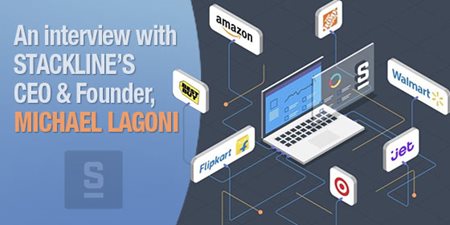Stackline CEO on Competitive Module for Digital Advertisers
By Gabriella Pirrone
April 10, 2019
Advertising, Advertising Cloud Creative, Amazon, Cloud, conversion, data, ecommerce, mobile apps, Mobile Commerce, mobile marketing, Retail, social media, Stackline
As Amazon’s advertising platform continues to expand, brands need to have the right tools to make the most of their ad spend, and this is where Stackline comes into play.
Stackline, a retail intelligence company, and one of Amazon’s largest advertisers announced a new AI module that gives brands visibility into the performance of US$4 billion in competitive advertising spent on Amazon US. Since leveraging this new tool, several clients using Stackline and the data gathered have already seen a profitability increase  of up to 58% and also expect to net US$11 billion in advertising revenue in 2019.
of up to 58% and also expect to net US$11 billion in advertising revenue in 2019.
The recent press release reports, “the new Stackline software module offers unprecedented insight into consumer behavior prior to purchase, including their search behavior and engagement with paid ads. This helps brands better understand how their marketing efforts across multiple digital and social channels affect their e-commerce traffic and sales.”
I reached out to Michael Lagoni, CEO and Founder of Stackline directly to discuss this announcement more in detail and to find out why there are gaps or missed opportunities that happen within e-commerce channels, the challenges for brands as online marketplaces continue to evolve, and how data plays a crucial role in accelerating sales online.
Brand Challenges and Opportunities
With the rise of mobile, social, and cloud technologies, customer expectations continue to increase. Now, more than ever, customers demand a more seamless experience. This can spark challenges for brands but can also open up many opportunities. Michael had mentioned in the press release that “the e-commerce channel is won by increments, and any gaps can lead to missed opportunities. We’re here to deliver the full picture, helping clients find those opportunities to gain a competitive edge.” I asked Michael what some of the gaps and missed opportunities are that brands and manufacturers are noticing with e-commerce channels?
“Brands selling in e-commerce channels are driving traffic to their products through digital advertising platforms that often treat all impressions, clicks, and conversions as equals. But we encourage brands to consider incrementality at each of those stages of the funnel: is this a net-new customer reaching your product as a direct result of your campaign, or was this customer likely headed into your conversion funnel anyway? Understanding the incremental sales revenue driven by each incremental dollar of investment is critical to making sound decisions about how to tune budgets across channels. We’re seeing more of our clients turn to our tools, like the new Traffic module, to help them track their marketing dollars to the point of purchase and make adjustments based on a clear-eyed assessment of return.”
With that being said, I was also curious about the most significant opportunities and challenges for brands as online marketplaces continue to evolve:
“Brands face new complexities as they try to manage marketing budgets and inventory allocation across an increasing number of platforms. These platforms have historically not communicated well with each other, and tracking and attributing an ad click from, for example, a social platform to a purchase on an e-commerce platform is not a straightforward exercise. And from a profitability perspective, inventory planning and forecasting across multiple e-commerce platforms is not a simple math problem. Those two challenges were a large part of the inspiration for our latest release, which gives brands a unified view of KPIs through their conversion funnel and across channels.”
How Data Can Improve Sales
In a post written by my former colleague Laura Myers, she highlighted how the importance of data was becoming a mainstay more than it ever had before, and the role that data would play in accelerating sales online could prove monumental. I asked Michael to share his thoughts on the role that data plays in stimulating sales online.
“The right data drives effective decision-making by answering core questions at every stage of investment. Which marketing opportunities deserve additional advertising dollars based on ad-attributed sales? Which keywords will drive SEO and paid traffic, and how should that change content or bidding strategy? How much inventory should be allocated to each e-commerce channel to maximize profit? Brands that can bring data to bear on these questions find competitive advantages and more opportunities for growth.”
The right digital merchandising strategy can engage your shoppers, guide them toward enticing products, and boost sales and long-term loyalty; essentially, the dream of any e-commerce business owner.
Still, landing on that perfect optimization strategy is more challenging than it seems. There are dozens of techniques, tools, and approaches you can use, each one having their pros and cons. I asked Michael how brands can leverage advertising, traffic, and merchandising data from online marketplaces such as Amazon to improve sales.
“All of these metrics accrue to the same question of how a brand should optimize paid and organic content to more efficiently drive customers through the conversion funnel. The right data set will link causes and effects at every stage to show how advertising and merchandising affect share of traffic, sales, market share, and profitability. Each key performance indicator by itself does not tell a persuasive story. The key is to connect the dots, identify the causes of growth and contraction in the business and then allocate investment accordingly.”
Ending Notes
As one of Amazon’s largest advertisers—helping clients earn more than $30 billion in e-commerce sales revenue just in the last year—Stackline has worked with clients such as Google, Sony, Starbucks, and Clorox, to name a few.“We offer advertisers a more complete view of their e-commerce performance and give them the resources to optimize their investment in the channel,” says Michael.
If you're looking for some more tips on how Amazon can help you with your e-commerce brand, I'd highly recommend checking out this post, where Michael discusses five non-intuitive things you need to know to run a very successful Amazon business.

Gabriella Pirrone
Gabriella is the Digital Marketing Assistant for CMSC Media. She brings a wealth of knowledge from not only a CMS perspective but also content, SEO and eCommerce. She enjoys everything social media and staying ontop of the latest trends in the digital marketing world.